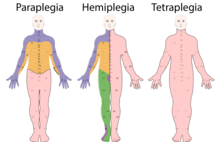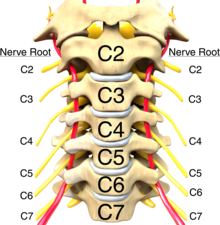User:Tdaprano/Tetraplegia
Tetraplegia, also known as quadriplegia, is paralysis caused by illness or injury that results in the partial or total loss of use of all four limbs and torso; paraplegia is similar but does not affect the arms. The loss is usually sensory and motor, which means that both sensation and control are lost. The paralysis may be flaccid or spastic.
| Tetraplegia | |
|---|---|
| Other names | Quadriplegia |
 | |
| Specialty | Neurosurgery,Physical Medicine & Rehabilitation |
| Types | Complete, incomplete |
| Causes | Damage to spinal cord or brain by illness or injury; congenital conditions; |
| Diagnostic method | Based on symptoms, medical imaging |
Signs and symptoms[edit]
Although the most obvious symptom is impairment of the limbs, functioning is also impaired in the torso. This can mean a loss or impairment in controlling bowel and bladder, sexual function, digestion, breathing and other autonomic functions. Furthermore, sensation is usually impaired in affected areas. This can manifest as numbness, reduced sensation or burning neuropathic pain.[citation needed] Secondarily, because of their depressed functioning and immobility, people with tetraplegia are often more vulnerable to pressure sores, osteoporosis and fractures, frozen joints, spasticity, respiratory complications and infections, autonomic dysreflexia, deep vein thrombosis, and cardiovascular disease.[1]
The severity of the condition depends on both the level at which the spinal cord is injured and the extent of the injury. An individual with an injury at C1 (the highest cervical vertebra, at the base of the skull) will probably lose function from the neck down and be ventilator-dependent. An individual with a C7 injury may lose function from the chest down but still retain use of the arms and much of the hands. An individual in between, with a C5 injury may lose some function from the chest down and fine motor skills in his/her hands but still have flexion and extension abilities of certain muscles around the back or arm area.
The extent of the injury is also important. A complete severing of the spinal cord will result in complete loss of function from that vertebra down. A partial severing or even bruising of the spinal cord results in varying degrees of mixed function and paralysis. A common misconception with tetraplegia is that the victim cannot move legs, arms or any of the major function; this is often not the case. Some individuals with tetraplegia can walk and use their hands, as though they did not have a spinal cord injury, while others may use wheelchairs and they can still have function of their arms and mild finger movement; again, that varies on the spinal cord damage.[citation needed]
It is common to have movement in limbs, such as the ability to move the arms but not the hands, or to be able to use the fingers but not to the same extent as before the injury. Furthermore, the deficit in the limbs may not be the same on both sides of the body; either left or right side may be more affected, depending on the location of the lesion on the spinal cord.
Another important fact to keep in mind would be the possibility to see a person with quadriplegia moving any areas affected by the injury sporadically. One of the main causes for this would be myoclonus, or muscle spasms. "After a spinal cord injury, the normal flow of signals is disrupted, and the message does not reach the brain. Instead, the signals are sent back to the motor cells in the spinal cord and cause a reflex muscle spasm. This can result in a twitch, jerk or stiffening of the muscle.
Anatomy & Function[edit]
Since tetraplegia is defined as dysfunction in the cervical spinal cord, this section will focus on the anatomy of the cervical spinal cord. To understand how tetraplegia presents after injury, it is imperative to have a broad knowledge of the cervical spinal roots and it's many functions. In the cervical spine, nerve roots exit the spine above the associated vertebra (i.e. the C6 nerve root exits above the C6 vertebra). By evaluating what nerve root of the cervical spine is injured, the affected muscle groups and dermatomes can be determined. This informs the evaluator as to what activities may be limited as a result of the injury. This is typically done at 72 hours post-injury; exams done prior to this time have been found to be inaccurate due to the presence of swelling and other confounding factors. For example, an injury at the C6 nerve root level will will affect the function of the triceps (elbow extension) but the biceps (elbow flexion) will be spared; in this case, an injury at the C6 root level affects all function at that level and below whereas the C5 nerve root, which controls the biceps, is spared since it is above the C6 level in the spinal column. When classifying an individual's level of function, there are numerous functional assessment tools that may be used in a clinical setting and it is often up to the clinician's discretion as to which tools are used. A comprehensive list of these tools may be found on the ShirleyRyan AbilityLab website.
| Root | Muscle Group | Root | Sensory Point | Expected Function |
|---|---|---|---|---|
| C2 | - | C2 | > 1cm lateral to the occipital condyle | - |
| C3 | - | C3 | supraclavicular fossa at the midclavicular line | - |
| C4 | - | C4 | Over the acromioclavicular joint | - |
| C5 | Elbow flexors | C5 | Lateral antecubital fossa | - |
| C6 | Wrist extensors | C6 | Dorsal thumb | - |
| C7 | Elbow extensors | C7 | Dorsal middle finger | - |
| C8 | Long finger flexors | C8 | Dorsal little finger | - |
| T1 | Small finger abductors | T1 | Medial epicondyle of the elbow | - |
| T2 | - | T2 | Apex of the axilla | - |

